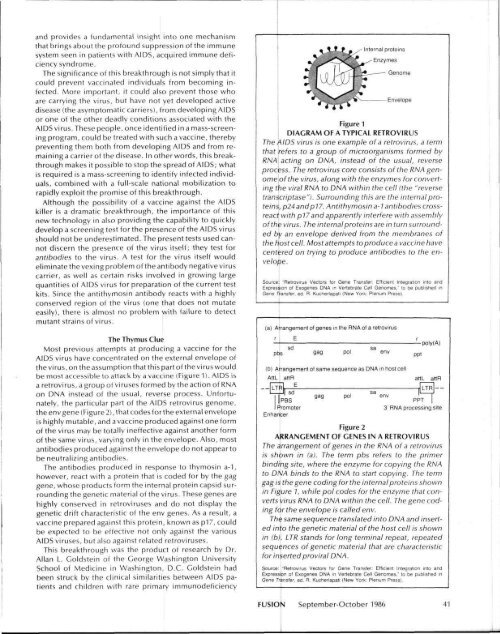You also want an ePaper? Increase the reach of your titles
YUMPU automatically turns print PDFs into web optimized ePapers that Google loves.
and provides a fundamental insight into one mechanism<br />
that brings about the pr<strong>of</strong>ound suppression <strong>of</strong> the immune<br />
system seen in patients with AIDS, acquired immune deficiency<br />
syndrome.<br />
<strong>The</strong> significance <strong>of</strong> this breakthrough is not simply that it<br />
could prevent vaccinated individuals from becoming infected.<br />
More important, it could also prevent those who<br />
are carrying the virus, but have not yet developed active<br />
disease (the asymptomatic carriers), from developing AIDS<br />
or one <strong>of</strong> the other deadly conditions associated with the<br />
AIDS virus. <strong>The</strong>se people, once identified in a mass-screening<br />
program, could be treated with such a vaccine, thereby<br />
preventing them both from developing AIDS and from remaining<br />
a carrier <strong>of</strong> the disease. In other words, this breakthrough<br />
makes it possible to stop the spread <strong>of</strong> AIDS; what<br />
is required is a mass-screening to identify infected individuals,<br />
combined with a full-scale national mobilization to<br />
rapidly exploit the promise <strong>of</strong> this breakthrough.<br />
Although the possibility <strong>of</strong> a vaccine against the AIDS<br />
killer is a dramatic breakthrough, the importance <strong>of</strong> this<br />
new technology in also providing the capability to quickly<br />
develop a screening test for the presence <strong>of</strong> the AIDS virus<br />
should not be underestimated. <strong>The</strong> present tests used cannot<br />
discern the presence <strong>of</strong> the virus itself; they test for<br />
antibodies to the virus. A test for the virus itself would<br />
eliminate the vexing problem <strong>of</strong> the antibody negative virus<br />
carrier, as well as certain risks involved in growing large<br />
quantities <strong>of</strong> AIDS virus for preparation <strong>of</strong> the current test<br />
kits. Since the antithymosin antibody reacts with a highly<br />
conserved region <strong>of</strong> the virus (one that does not mutate<br />
easily), there is almost no problem with failure to detect<br />
mutant strains <strong>of</strong> virus.<br />
<strong>The</strong> Thymus Clue<br />
Most previous attempts at producing a vaccine for the<br />
AIDS virus have concentrated on the external envelope <strong>of</strong><br />
the virus, on the assumption that this part <strong>of</strong> the virus would<br />
be most accessible to attack by a vaccine (Figure 1). AIDS is<br />
a retrovirus, a group <strong>of</strong> viruses formed by the action <strong>of</strong> RNA<br />
on DNA instead <strong>of</strong> the usual, reverse process. Unfortunately,<br />
the particular part <strong>of</strong> the AIDS retrovirus genome,<br />
the envgeneiFigure 2), that codes for the external envelope<br />
is highly mutable, and a vaccine produced against one form<br />
<strong>of</strong> the virus may be totally ineffective against another form<br />
<strong>of</strong> the same virus, varying only in the envelope. Also, most<br />
antibodies produced against the envelope do not appear to<br />
be neutralizing antibodies.<br />
<strong>The</strong> antibodies produced in response to thymosin a-1,<br />
however, react with a protein that is coded for by the gag<br />
gene, whose products form the internal protein capsid surrounding<br />
the genetic material <strong>of</strong> the virus. <strong>The</strong>se genes are<br />
highly conserved in retroviruses and do not display the<br />
genetic drift characteristic <strong>of</strong> the env genes. As a result, a<br />
vaccine prepared against this protein, known as p17, could<br />
be expected to be effective not only against the various<br />
AIDS viruses, but also against related retroviruses.<br />
This breakthrough was the product <strong>of</strong> research by Dr.<br />
Allan L. Goldstein <strong>of</strong> the George Washington University<br />
School <strong>of</strong> Medicine in Washington, D.C. Goldstein had<br />
been struck by the clinical similarities between AIDS patients<br />
and children with rare primary immunodeficiency<br />
Figure 1<br />
DIAGRAM OF A TYPICAL RETROVIRUS<br />
<strong>The</strong> AIDS virus is one example <strong>of</strong> a retrovirus, a term<br />
that refers to a group <strong>of</strong> microorganisms formed by<br />
RNA acting on DNA, instead <strong>of</strong> the usual, reverse<br />
process. <strong>The</strong> retrovirus core consists <strong>of</strong> the RNA genome<br />
<strong>of</strong> the virus, along with the enzymes for converting<br />
the viral RNA to DNA within the cell (the "reverse<br />
transcriptase"). Surrounding this are the internal proteins,<br />
p24andp17. Antithymosin a-1 antibodies crossreact<br />
with p!7 and apparently interfere with assembly<br />
<strong>of</strong> the virus. <strong>The</strong> internal proteins are in turn surrounded<br />
by an envelope derived from the membranes <strong>of</strong><br />
the host cell. Most attempts to produce a vaccine have<br />
centered on trying to produce antibodies to the envelope.<br />
Source: "Retrovirus Vectors for Gene Transfer: Efficient Integration into and<br />
Expression <strong>of</strong> Exogenes DNA in Vertebrate Cell Genomes." to be published in<br />
Gene Transfer, ed. R. Kucherlapati {New York: Plenum Press).<br />
Figure 2<br />
ARRANGEMENT OF GENES IN A RETROVIRUS<br />
<strong>The</strong> arrangement <strong>of</strong> genes in the RNA <strong>of</strong> a retrovirus<br />
is shown in (a). <strong>The</strong> term pbs refers to the primer<br />
binding site, where the enzyme for copying the RNA<br />
to DNA binds to the RNA to start copying. <strong>The</strong> term<br />
gag is the gene coding for the internal proteins shown<br />
in Figure 7, while pol codes for the enzyme that converts<br />
virus RNA to DNA within the cell. <strong>The</strong> gene coding<br />
for the envelope is called env.<br />
<strong>The</strong> same sequence translated into DNA and inserted<br />
into the genetic material <strong>of</strong> the host cell is shown<br />
in (b). LTR stands for long terminal repeat, repeated<br />
sequences <strong>of</strong> genetic material that are characteristic<br />
for insertedproviral DNA.<br />
Source: "Retrovirus Vectors tor Gene Transfer: Efficient Integration into and<br />
Expression <strong>of</strong> Exogenes DNA in Vertebrate Cell Genomes." to be published in<br />
Gene Transfer, ed. R. Kucherlapati (New York: Plenum Press).<br />
FUSION September-October 1986 41

















